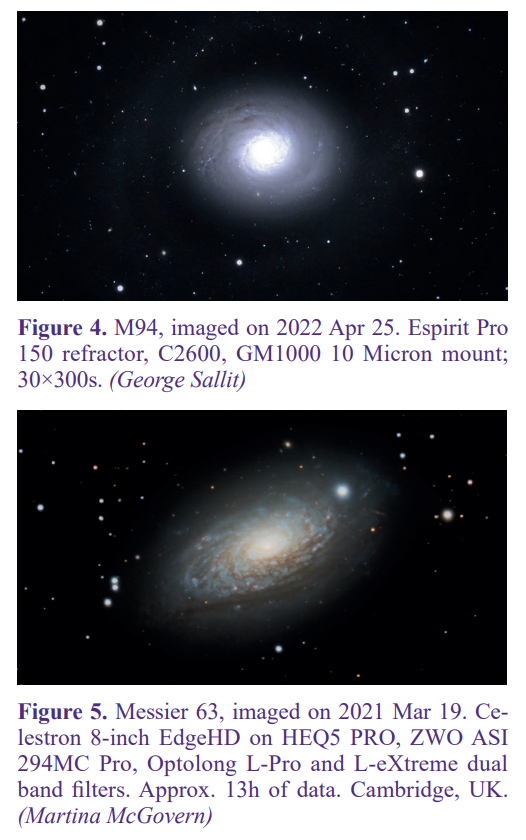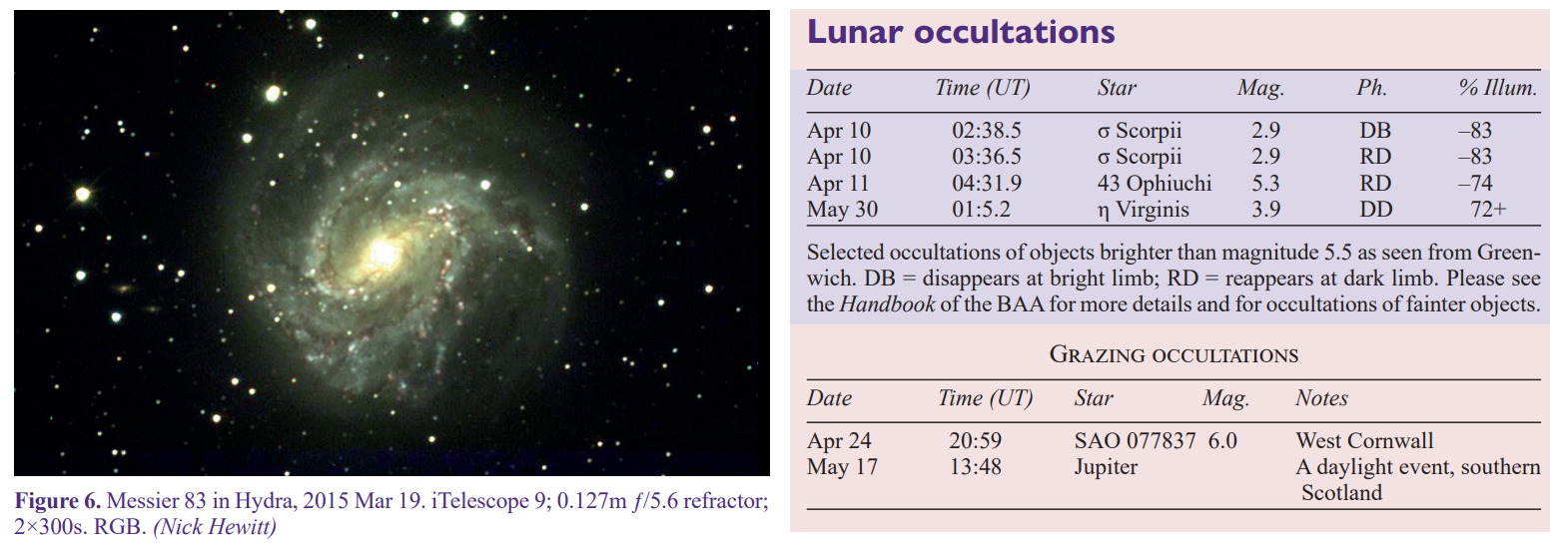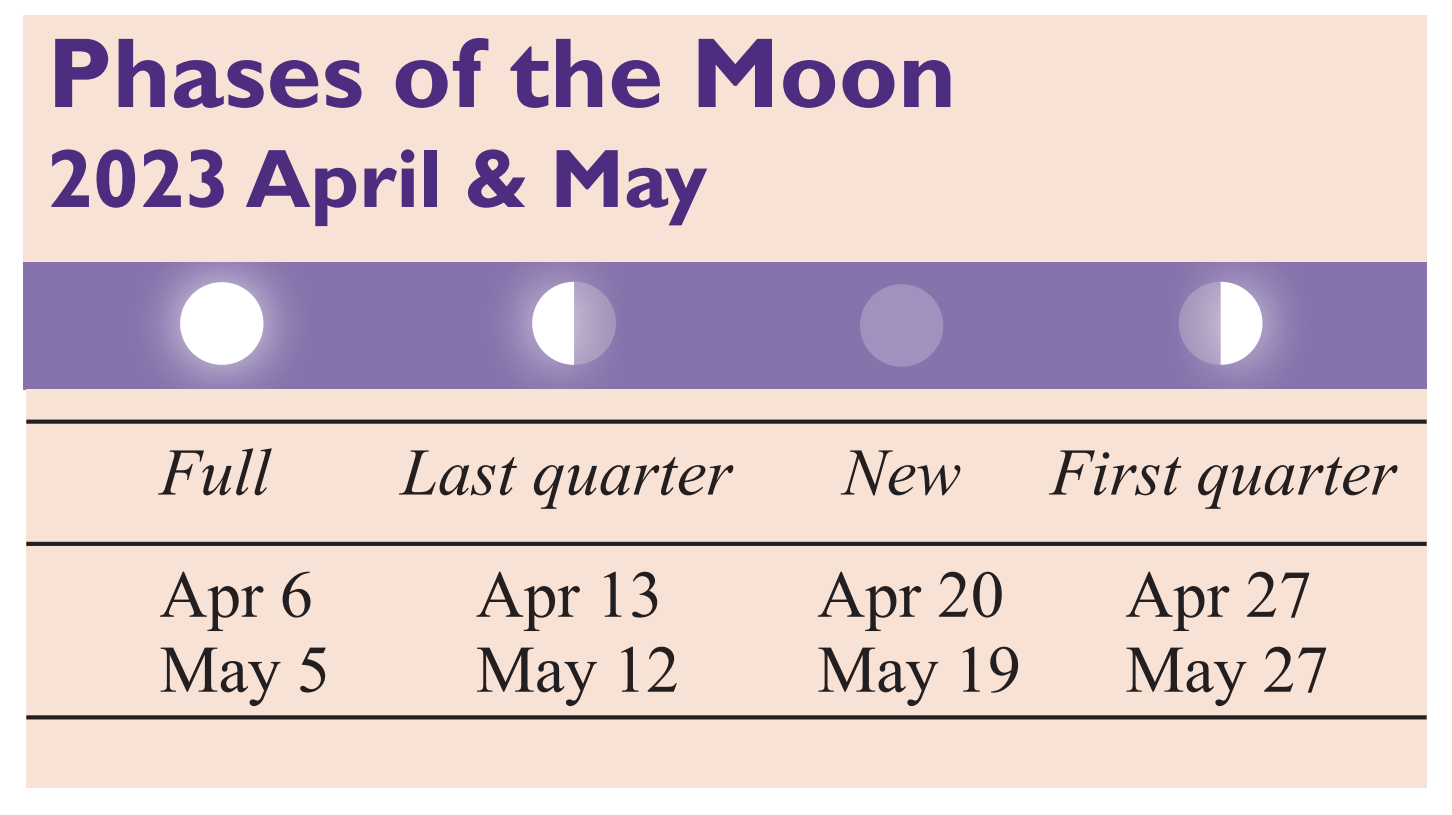Sky notes for 2023 April & May
2023 April 1

On May 6, the UK marks the first coronation for 70 years, so perhaps it is appropriate to commence these Sky Notes with Corona Borealis, the Northern Crown. After all, it is probably the first coronation in the lives of many members, and only the second for a minority by now.

This small circlet of stars is an easily identified asterism north-east of bright orange Arcturus in Boötes. Its brightest star Gemma (or Alphecca) is the central jewel in the diadem, but the Crown’s most interesting stars are the two famous variables R Corona Borealis and T Corona Borealis. R CrB is a sooty carbon star that fades dramatically from time to time; the last deep fade was from 6th to 14th magnitude between 2015 and 2017, and there was a small dip to 9th magnitude in 2019, but it seems to have steadied to 6th magnitude at present. T CrB is very different, being a recurrent nova. Normally a 10th-magnitude star, it has flared to magnitude 2.0 (1866) and 3.0 (1946); it can fluctuate by a magnitude on much shorter time scales. It is always worth looking at the Northern Crown to see if R has faded, or T has brightened.

Another crown becomes prominent ‘down under’ towards the end of May. Corona Australis rises high in the antipodes during our midsummer, but May heralds open season on the Corona Australis variable nebula NGC 6729, which is near to the fine globular cluster NGC 6723 and close to the pretty reflection nebula complex NGC 6726–7. (See Journal 132(1) for a full analysis of observations of the variable nebula.) This area lies under the Teapot asterism in Sagittarius and is thus unavailable from the UK, but accessible from southern Europe and by users of remote telescopes.
Although British Summer Time arrived at the end of March, long observing sessions are still available in April. However, by the end of May the short nights are frustrating, especially as the outer planets are not conspicuous as yet. Venus dominates the scene in the evening as a brilliant beacon in the west. During April, we lose the winter wonders into the west and the Milky Way lowers towards the north, leaving us to gaze away to the congested plane of the Milky Way galaxy towards the Coma–Virgo Cluster of galaxies. The ‘Realm of the Galaxies’ is a feast of fun challenges to delight enthusiasts of ‘faint fuzzies’.
Another loose royal connection can be enjoyed in the star Cor Caroli (alpha Canum Venatici). The star sits under the elongated tail of the Great Bear (Ursa Major) but is most easily located by extrapolating a line from Dubhe (alpha Ursae Majoris) to Phad (gamma UMa). The name is unusual and its derivation controversial, being added to atlases in 1660 after Charles II returned during the restoration of the monarchy, but this name may well have been more in remembrance of his late father, the executed Charles I. Cor Caroli translates to ‘Heart of Charles’ and it was said by Sir Charles Scarborough, royal physician to Charles II, that the star shone with especial brilliance on the eve of the king’s return to London. Although the star has been suspected of slight variability, this was likely to be monstrous sycophancy! Either way, the name has stuck. Cor Caroli is an easy double star for small telescopes, the components (magnitude 2.89 and 5.60) being 19 arcseconds apart in position angle 228°. They are a common-motion pair. Both are white to most observers, although subtle tints have been recorded.

Canes Venatici, the Hunting Dogs, is a constellation full of accessible galaxies as most lie nearer to us than the main Virgo Cluster. The great Whirlpool Galaxy, Messier 51, is the best known and much imaged, being easily located near Alkaid (eta UMa). Bright Messier 106 is also a popular target. More overlooked galaxies of note include Messier 94 and Messier 63. M94 is easily found but difficult to resolve. It is at the northern apex of a shallow triangle with Cor Caroli and Chara (beta Canum Venaticorum), a compact spiral of magnitude 8.2 and a slightly oval 11.2×9.1 arcminutes. The bright central portion is easy, but the tightly wound spiral arms are hard to discern.
More difficult to pin down is M63, sometimes known as the Sunflower due to its flocculated spiral arms. To the east and slightly north of M94, it should be visible in a large finder a little north of a triangle of 4th- and 5th-magnitude stars. It is magnitude 9.3 and 12.6×7.2 arcminutes but has lower surface brightness than M94. On images, the clumpy nature of the spiral arms is striking.
South of Canes Venatici lie the tresses of Coma Berenices (Queen Berenice’s Hair). Dominated by a large, loose open cluster (Melotte 111), the constellation is still rich in galaxies both near to us and more distantly placed towards the rich centre of the Virgo Cluster itself. The Black Eye Galaxy, Messier 64, is a fine target, and the assorted star cities Messier 85, 88, 91, 98, 99 & 100 are well worth several nights of effort.

For those who enjoy a seasonal challenge, look for Messier 83 in Hydra, scraping the horizon 20° south of Spica (alpha Virginis). As it is less than 10° above the horizon from the most southerly parts of the UK, more luck may be had for those on holiday further south or bagging it using remote set-ups. It is magnitude 7.5, 13×11.5 arcminutes in size, nearly face-on and with quite loose spiral arms. It has had a high supernova count, so if you can glimpse it, check the field for more. A superb galaxy!
If galaxies are not your thing, April and May are good months for some attractive double stars and Boötes, our celestial herdsman, abounds with them. Mu Boötis is a wide pair with common proper motion, separated by 107 arcseconds. The system is in fact quadruple, mu1 being a very tight binary of separation 0.08 arcseconds (ʺ) with a 260-year period. Mu2 is much more manageable, also being a binary but with components of magnitude 6.9 and 7.6, separated by 2.2ʺ in position angle 2° (in 2020).

Xi Boötis is a binary and naked-eye at magnitude 4.55, so easily found due east of Arcturus. Xi Boötis B is magnitude 6.8 and the orbital semi-major axis is 4.9ʺ, so easy for small telescopes even when the companions are at their closest. They are currently 6ʺ apart. The main joy of this binary is the unusual colour difference of pale yellow and reddish violet.
Epsilon Boötis (Izar) is a close double dubbed ‘Pulcherrima’ by F. G. W. Struve in 1829 for its lovely yellow 2.5-magnitude primary and bluish-green 5th-magnitude companion, which are just 2.8ʺ apart. Finally, iota Boötis is a binary with an elongated and narrow elliptical orbit. Unfortunately, the separation in 2023 renders splitting the components difficult as they are 1.8ʺ apart (2020), although the magnitudes of 5.3 and 6.2 make separating them feasible for larger telescopes. The secondary star is a dwarf eclipsing system with an exceptionally short period of 6.427 hours: perhaps a precursor to a U-Geminorum-type dwarf nova.

The Sun has continued to be enjoyably active in late winter and the solar wind has produced many fine aurorae, seen from more northern latitudes.
There is a rare hybrid total solar eclipse on Apr 20, but unfortunately this is not visible from the UK as the path of the Moon’s shadow tracks across south-east Asia and just tips Australia at the small community of Exmouth, in the north-western part. A hybrid eclipse begins and ends as an annular eclipse, but as luck would have it, at Exmouth it is total for 62 seconds.
Two weeks after that eclipse, there follows a penumbral lunar eclipse on May 5 but again, sad to say, nothing is visible from the UK.
This is not a good time for enthusiasts of the gas and ice giants, all of which are either in conjunction with the Sun or morning objects scraping the horizon. To compensate, we have the inner planets well placed during some of the period.
Mercury reaches its eastern elongation on Apr 11, giving its best evening showing of the year for UK observers. Thereafter, inferior conjunction occurs on May 1 and it will then be too low, even by western elongation on May 29.
Venus is the solar system’s showpiece in April and May: a brilliant evening planet and the most stunning sight in the west. During May, it moves from Taurus into Gemini to reach greatest eastern elongation on Jun 4, when over 20 arcseconds in diameter and –4.4 in magnitude.
Mars fades and shrinks as Earth pulls away from the Red Planet. Positioned in Gemini in April, it is magnitude +1.3 and just six arcseconds in diameter. By the end of May it is in Cancer and a tiny 4.7 arcseconds; it is thus a target for only the most accomplished observers.
Jupiter is at conjunction on Apr 11 so not observable. It emerges into the morning sky low down in May. Await the autumn to resume study.
Saturn also emerges into the predawn sky very low in the south-east at the end April, moving into Aquarius by the end of May.
Uranus is still visible in early evening in Aries in April but is in conjunction by May. Neptune is not really available, although it might be glimpsed low down in Pisces at the end of May.
Of the dwarf and minor planets, (1) Ceres is well placed in Coma Berenices although near Denebola (beta Leonis) at magnitude 7. (7) Iris is at opposition on Apr 30 at magnitude 9.8.
Meteors
The April Lyrids are at their maximum on Apr 23, with a waxing crescent Moon not interfering. It is not normally a rich shower but rates can occasionally soar, so it is worth looking. The radiant is now in Hercules but near enough to Vega to make no difference.
The Eta Aquarids peak between May 5 & 7. The full Moon will interfere this year. The shower’s material is from comet 1P/Halley, and it represents the spring equivalent of the autumnal Orionids from the same famous visitor.
Comets
We have almost lost C/2022 E3 (ZTF) by early April as it moves slowly to the south-west of Rigel and into Eridanus; we will likely never have a good view of it again.
| The British Astronomical Association supports amateur astronomers around the UK and the rest of the world. Find out more about the BAA or join us. |
